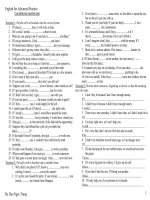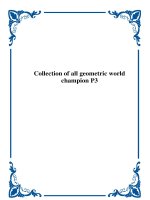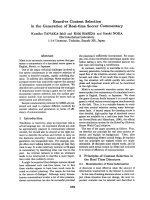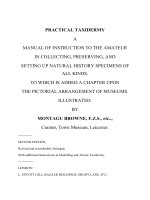105411283 greatest guitar solos of all time JPR504
Bạn đang xem bản rút gọn của tài liệu. Xem và tải ngay bản đầy đủ của tài liệu tại đây (34.55 MB, 69 trang )
THE RECORDING
,
Wolf Marshall: guitars
Michael Della Gala: bass
Mike Sandberg: drums, percussion
John Nau: keyboards
Gary Ferguson: additional drums
The titles in this book include:
"Hound Dog"-Elvis Presley (with Scotty Moore)
"No Particular Place to Go"-Chuck Berry
"The Sunshine of Your Love"-Cream
"l.ley
Joe"-Jimi Hendrix
"While My Guitar Gently Weeps"-The B'eatles (with Eric Clapton)
"The End"-The Beatles
"Babe I'm Gonna Leave You"-Led Zeppelin
"You.Shook
Me"-Led Zeppelin
"Evil Ways"-Santana
"l;s1 fllsp"-Black Sabbath
"All Right NoW'-Free
"Bohemian Rhapsody"-Queen
'Walk this Way"-Aerosmith
"Sultans of Swing"-Dire Straits
"You Really Got Me"-Van Halen
"Crazy Train"-Ozzy Osbourne (with Randy Rhoads)
"Crossfire"-Stevie Ray Vaughan
"Sweet Child
O'Mine"-Guns N'Roses
d
HOUND DOG
Words and Music by Jerry Leiber and Mike Stoller
Figurel -GuitarSolo
Scotty Moore is universally acknowledged as the world's first rock'n'
guitarist-a strong statement, perhaps...but consider this: His lead playing
on Elvis Presley records in the 1950s set in motion, and brought to mass
public attention, the art of rock guitar. Moore was the first rock guitar
innovator. His style was truly eclectic and pioneering. Working without a
preconceived blueprint, he freely combined elements from disparate
roll
influences such as country (Merle Travis and Chet Atkins), blues (B.B. King
and T-Bone Walker), and jazz (Barney Kesselland Johnny Smith)to form the
basis ol his influential guitar approach. Before Scotty, rock 'n' roll guitar was
an obscure and regional medium at best. With Scotty, rock'n' roll guitar was
codilied and at the center of a revolution in popular music. Scotty blazed the
trail for much of what followed, and inspired subsequent generations of
rockers including the Beatles, the Stones, Jimmy Page, and counlless others.
His solos from the Sun Sessions and the early RCA years are deemed by
most historians and legions of players to be the first of their kind-marking the
beginnings of a vital new artform which still shows no signs of abating some
45 years later.
Scotty Moore's guitar solo on "Hound Dog," a raucous #1 hit single for
, the King in August, 1956, is one of his all-time best. The brief but memorable
outing has many classic Moore signatures including swing-based, horn-like
lines, rockabilly-llavored double-stop bends, and gritty blues-oriented string
bending. lt's played over one chorus of a 12-bar blues in C.
Scales used: C minor pentatonic (C-Eb-F-G-Ab); C major
pentatonic (C-D-E-G-A); C Btues Scate (C-Eb-f-fil-O-Ab).
Significant added tones: Dfi (measure 5);A (measures 6-1i);
B (measure 7).
Solo signatures: Mixture of single-note and dyad textures;
double-stop bends; blues; country and swing phrasing within a rock'n'
roll context.
Performance notes: The single-note portions exploit a wider range of
the guitar than had been previously found in most early rock 'n' roll
single-note solos. These occur in the third, fifth, and eighth positions.
Though Scotty Moore generally played with a thumbpick and three
fingers, this sleek single-note solo sounds like he might be using only
the thumbpick or a flatpick.
Sound: Gibson L-5 archtop hollowbody electric guitar with P-90
pickups and Gretsch heavy-gauge strings; small, slightly overdriven
combo tube amps: Fender "TV-front" tweed Bassman or custommade Echo-Sonic amp built by Ray Butts.
0
o
Fig.
(right Channel of audio)
Gtr.
1 meas.
1-13
Slow Demos:
Gtr.'l meas. 1-3; 4-5;
6-9; 10-1 1:12-13
1
Guitar Solo
Moderately Fast shuffle
Gtr.
Featured Guitar:
) = 174 t "-]
l
t.lrl
10501
a
L minor
pen(atontc
C major pentatonic
1
C major pentatonic
C blues scale
U4
@
C minor pentatonic
@
C major pentatonic
Copyright @ 1956 by Elvis Presley Music, lnc. and Lion Publishing Co., lnc.
Copyright Renewed, Assigned to Gladys Music (Administered by Williamson Music) and MCA Music Publishing, A Division of Universal Studios, lnc.
lnternational Copyright Secured All Rights Reserved
NO PARTICULAR
PLACE TO GO
Words and Music by Chuck Berry
Figure 1 - Outro Guitar Solo
Chuck Berry is a true American icon and one of the most important
founding fathers of rock guitar. Anyone picking up the instrument post-1955
has been affected by him, directly or indirectly, and that includes the Beatles,
the Stones, Eric Clapton, Jimi Hendrix, Jimmy Page, Angus Young, Eddie Van
Halen, Stevie Ray Vaughan, or the latest kid on the block. Chuck's own
influences include blues guitarists Muddy Waters, T-Bone Walker, and Elmore
James; R&B players Carl Hogan and Lonnie Johnson; jazz guitarists Charlie
Christian and Django Reinhardt; and more esoteric musicians like
saxophonist lllinois Jacquet. He once stated that he did not recognize any
style of his own, though most historians regard his guitar style to be one of the
single most significant factors in the development of rock music.
"No Particular Place to Go" is a case in point. This song was one of
Chuck's biggest hits (#10 in 1964) and remains an immodal piece of the rock
guitar legacy-containing a must-know guitar solo in the outro. The outro solo
takes place over two choruses of a 12-bar blues in G, and exploits the
trademark rhythm-lead approach which exemplifies the Chuck Berry solo
, style.
Scales used: G Mixolydian mode (G-A-B-C-D-E-F); G Blues Scale
(c-Bb-c-Db-o-q.
Significant added tones: Eb-used as a passing tone in the blues
cadence of the last two measures.
Solo signatures: Shuffle-based blues feel; slurred triads and bent
double stops; scales and modes freely combined, harmonized in
parallel double stops, and played rhythmically.
Performance notes: The solo is almost entirely chordal, alternating
between triad and dyad textures. Chuck plays many of these chordal
sounds as thematic riffs. He introduces an idea and then develops it
by repetition in the following measures-as in measures 4-5, 6-9,
13-15, or 1B-19. During more aggressive dyad riffs, Berry strums the
figures and mutes out extraneous unwanted notes with the frethand.
The solo is situated in the "barre-chord" boxes (minor pentatonic
pattern 1) in G at the filteenth and third positions.
Sound: Gibson ES-355 or ES-345 with two humbucking pickups and
vibrola tailpiece; slightly overdriven Fender combo tube amps and
Fender Dual Showman piggyback amps.
Fig.
1
E
Moderate Rock J = 132
(J-]
_i_
=J .[)
Outro Guitar Solo
ctr. 2: w/ Riy. Fig. l
G
G Mixolydian mode
G Mixolydian mode
Rhy. Fig.
G blues scale
l
CtI.2
Copyright @ 1964, 1965 (Renewed), 1973 by Arc Music Corporarion (BMl)
lnternational Copyright Secured All Rights Reserved
Used by Permission
G blues scale
G blues scale
G blues scale
AAAAA
G blues scale
G Mixoiydian mode
C
G
,,\AAAAAAAlr
E
10
G Mixolvdian mode
G Mixolydian mode
G blues scale
G blues scale
G blues scale
G Mixolydian mode
l-J'
1/4
Gtr.
24
1
G
'Jl
1t4
1/4
1/4
t/4
U4
@
Ab7
G7
11
SUNSHINE OF YOUR
LOVE
Words and Music by Jack Bruce, Pete Brown, and Eric Clapton
Figurel-GuitarSolo
Eric Clapton was rock's first guitar virtuoso. With Cream, rock's first
power trio, Clapton sel the tone and attitude for electric guitar soloing in the
sixties and beyond. His fusion of Chicago and Texas blues with British hard
rock marked a new direction in modern music and remains the standard by
which most rock solos are judged. Eric's groundbreaking efforts with Cream
laid the foundation for the incipient genres of hard rock and metal, as in the
Jimi Hendrix Experience, Led Zeppelin, Black Sabbath, and other bands too
numerous to name. His influence was enormous and pervasive. Hendrix
refused to emigrate to England until he was promised he would meet Clapton,
and even futuristic jazz guilarist Allan Holdsworth cites Eric as a seminal
influence, as do contemporary virtuosi Eddie Van Halen and Eric Johnson.
"Sunshine of Your Love" was unarguably Cream's biggest hit-#S in
1968. Recorded in 1967, the song contains Clapton's most well-known solo of
the era-which is saying a lot. Played over an expanded, twenty-fourmeasure "altered blues progression" in D, the signature rock solo features
many of his most unmistakable traits. Clapton's main influences as an electric
guitar soloist included the Kings (B.8., Albert, and Freddie), Otis Rush, and
Buddy Guy. Many of these influences are heard, often in mutated form, during
the course of the "Sunshine of Your Love" solo.
Scales used: D minor pentatonic (D-F-G-A-C); D major pentatonic
(D-E-Ff-A-B).
Significant added tones: B (measure Z); Gil (measures 6 and
B).
Solo signatures: Major and minor scale combining; wide string
bending and vibrato; use of amp sustain and overdrive distortion to
create a vocal sound.
Pedormance notes: This classic solo is a virtual textbook of Clapton
guitar moves. The blues-based wide string bends and vibrato (as in
the major third bends of measure 10) require considerable hand
strength and are best performed with reinforced lingering (more than
one finger pushing the string)-a very visible Clapton technique. The
pre-bends and held bends in measures 4 and 5, as well as the doublestop bends in measures 6 and 8, similarly benefit from reinforced
fingering. The solo is situated in blues-box positions in D at the
seventh, tenth, and twelfth frets (patterns 5, 1 , and 2).
Sound: Gibson SG/Les Paul Standard with two humbucking pickups;
overdriven 1O0-watt Marshall stacks with 4x12 cabinets.
12
G
rrrm
ffi
Fig.
1
[E
ModerateRockJ
o
0
Featured Guitars:
1 meas. 1-2
Gtr.2 meas. 2-26
Gtr.2 meas. 27-30
Gtr.
Slow Demos:
Glr.2 meas. 2-9;
10-'15; 16-21;
22-27
Guitar Solo E:011
=112
A
l-
D
CDN.C.
IiAAAAAAAt
<>
f
'j'
full
lu11
+Key signature denotes D Dorian.
CDN.C
DCDN.C.
[w
M
Copyright O 1968, 1973 by Dratleaf Ltd.
Copyright Renewed
All Rights Administered by Unichappell Music lnc.
lnternational Copyright Secured All Rights Reserved
13
W
lJl
grad. bend
lt2
1/2
3/4 l1t4
W
full
t
FGN.C
G
I
f-
x> lAA,t'
l^
t{tmtlnlnmml
!f AA^^f
lryl|/l AAAA,|
l.'-
full
DCDN.C
i/l^/to
Lj--l
1
14
ll2
full
IryIAAAAAAAAAAAA/}
t/t
A/}
oGDF @o
10fr
-h-\l)1
crr.r/
t
10fr
8fr
)t
)
D
@
1Ofr
)
/
t^
I \11
/x/
I
t
Gtt.2
>7\ tm,rmn'r 3 \
tAA/y)
t a'ti/yt{/w
)-
TAAAAA'AAI
'Ittrylttm,*
A
f'
/ /
N>
21^ i:,
!,
ii
I
7 n.lr
,a,^
:
\
,r>
/,,\
C
I
/
I
A
G
\ll
X/
t
I
I
\v
X
|-.=
))
\v
X
7\
t'vyrf
L
++
tt=
F F
Ft\:
X
,z\
tr'
D
I
lX/X
.i
>//---
Gtr.2 D
^/t
\11
llv
/w
|-l
))
n
r-
)
-
))
-=
)
)
) )
ffi
@
1Oft
t-]
a-/a
(cont. in notation)
?\>
D
N.C.
DCDN.C
27
15
HEY JOE
Words and Music by Billy Roberts
Figurel-GuitarSolo
Jimi Hendrix is rock's ultimate guitar hero. He effectively moved rock
guitar from the electrified blues genre of the sixties into uncharted regions ol
the 21st century-and we still haven't caught up with him! An intensely
creative and multi-faceted player, Jimi was brought up on blues and R&Bfavorites included Howlin'Wolf, Muddy Waters, B.B. and Albert King, Elmore
James, and Buddy Guy as well as Curtis Mayfield and James Brown. He
combined and transformed a wide array of influences as both a musician and
composer to produce a powerful legacy of sounds and techniques not
equalled or surpassed to the present day.
"Hey Joe" was Jimi's first hit and interestingly was not his original
composition. ln facl, the Billy Roberts tune received multiple covers in the
mid-sixties (even one by Cher) before Hendrix touched it. However, once Jimi
made it his debut single in 1967, he owned it. From then on, his was the
definitive version. The song became a vehicle for Jimi's patented lead-rhythm
comping approach and the perfect setting for one of his famous guitar solos.
ln contrast to most of the extended, psychedelic rave-up
improvisations of his career, this signature eight-measure Hendrix solo is
brief, economical, and highly accessible. lt occurs over two cycles of the
tune's C-G-D-A-E verse changes, and culminates in a walking ensemble
line with the bass for a funky R&B finish.
Scales used: E minor pentatonic (E-G-A-B-D).
Significant added tones: Cf and Ffi (measure
8).
Solo signatures: Blues melody, feel, and phrasing despite non-blues
musical environment; string bending and vibrato; double stops
(measure 6); intervaljumps of a sixth and a fourth in the minor
pentatonic scale (measure 6).
Performance notes: Jimi's solo is primarily situated in the twelfth
position E blues box. Reinforced fingering is used for the string bends
and henceforth-due in great part to Hendrix's influencebecame a norm in rock guitar solos. The double stops in measure 6
indicate the presence of Jimi's chord-melody conception in largely
single-note solos.
Sound: Fender Stratocaster; slightly overdriven 1OO-watt Marshall
stacks.
16
Fig.
0
o
1
Moderately Slow Rock J = 88
Gtt.2
Featured Guitars:
Gtr.2 meas. 1-9
Gtr.1 meas. 10 -13
Slow Demos:
Gtr.2 meas.
2-5;
6-9
*E
*Audio fades in 3 meas. before Fig.
1
G(add9)
D
tA ryyt/t/t/w lA
ri
{AA/}
h.
^A
tz'C
',
tlt*tlt
*'
Jl
full
tft
*T=Thumbon
E
;
AA AAt
Ttuml
@
N.C.
iAAAAAII
.tyt/w
@ 1962 (Renewed) by THIRD STORY MUS|C, tNC.
All Rights Reserved lnternational Copyright Secured
17
T-31 ;31
18
;31
WHILE MY GUITAR
GENTLY WEEPS
Words and Music by George Harrison
Figurel -GuitarSolo
This classic cut from the Beatles' White Album of 1968 is
dislinguished by one of the most notable guest spots in rock history. At
composer George Harrison's insistence, British blues-rock virtuoso Eric
clapton sat in with the world's biggest and most important band, a first, on the
landmark track "while My Guitar Gently weeps." Eric had done a number of
sessions prior to the date (Aretha Franklin, otis spann, champion Jack
Dupree, Jackie Lomax, Martha Velez), but this proved to be a career high
point. The momentous solo was recorded during a Beafle session on
September 6, 1968, at Abbey Road Studios in London.
Eric clapton's eight-measure contribution suits the tune perfecily-in
both a melodic and thematic sense. over the song's mixed-mode chord
changes in A minor, Eric produces one of his most emotional and well-crafted
signature solos of alltime. The climax phrase in the last measure contains an
ascending run in a faster sixteenth rhythm which would become a recurring
concept in many future rock solos.
Scales used: A minor pentatonic (A-C-D-E-G).
Significant added tones: B and Cf, lpict
Solo signatures: Blues melody and vocal guitar phrasing within a
non-blues context; wide string bends and vibrato; compositional
structure.
Performance notes: This Clapton solo is based entirely on the A
minor pentatonic scale and is played almost exclusively in the twelfth
position. Rather than motion, the focus is on emotion-string bends of
practically infinite variety to emphasize the weeping theme of the
composition. Of these, note particularly the pre-bends in the pickup
and measures 4-6, and the wide string bending and wide vibrato in
measures 3-6. The wide bends of a minor third (A to C) are slowly
released while vibratoed for a particularly expressive crying effect.
Sound: Gibson Les Paul Standard; overdriven Marshall amp;ADT
(Automatic Double Tracking, a studio chorusing effect) added to the
guitar solo after it was recorded.
19
o
0
Fig. I
Am/G
+ffi
F
DgtF+
g
ft
*,j?H
ffi
D
G
C
FH++1
lH+fl
FFi.FH
FIH+I
tgiri
g
II]]E
F+IH
t342tl
21
Featured Guitar:
GIr.2 meas.
1-17
Slow Demos:
Gtr.2 meas.
1-17
E'7
TFI
H
FH-+11
34
Guitar Solo
n)
Am
tt
//
l^/l /l /r/r/yL
,-L1,'^
n
Am/G
ttt
/lf
A minor pentatonic (continued throughout)
^
->
Ni/i'l,l}rl,i/i'i'i,i/ll.lt
c. -t-
f
))fTn
)Tn))fTD)
Am
De/F#
W
------'----------\
.-\
))
W
.-_/>
#-J\
grad. release
11/2w
+"t
ta
20
ry2
i'(l /t /t A/}aAAaf/w
full
O 1968 HARRISONGS LTD.
Copyright Renewed
lnternational Copyright Secured All Rights Reserved
Am/G
1172
VllA,tlA,tlt
D
))
vt/}
L,
fTT fTT)
8va
fTn))
//
'TT)
------------------
De/Ff
lltt
) ) D)
Am
8vq----------------.
fTT) )
F
)
rTT)
VTAAAAATh/}
1^
^-i-".---'-
full
fD1 ))fTn)
full
) fTn rTn rTn
Ai\
\--/
\.-_9
NI
THE END
Words and Music by John Lennon and Paul McCartney
Figure 1 - Chorus and Guitar Solos
Abbey Road (1969) marked the last musical moments of the Beatles'
illustrious career. The album's final moments, appropriately titled "The End,"
featured an auspicious solo in which all three guitar-wielding players traded
back-to-back signature licks. By this point, the role and concept of the
"Beatles lead guitarist" was completely blurred. Paul McCartney, George
Harrison, and John Lennon equally and routinely handled solos on the band's
various tracks as the situation arose.
ln "The End," Paul, George, and John (in that running order) play off
each other in a spirited guitar trio, and present us with an ideal opportunity to
examine their individual lead styles. The solo takes place over a vamp of A7
to D7-somewhat like the first two measures of a blues progression in A.
Each player handles his two-measure spot differently and assumes a
contrasting guitar tone.
Scales used: All three soloists-A minor pentatonic (A-C-D-E-G);A
Blues Scale (A-C-D-Dil-E-G).
Significant added tones: Dfi (measure 27) and Cfi (measure 31),
both as a result of string bends; B (measure 32); Fil (measures
44-45).
Solo signatures: Paul-semi-clean guitar tone, with an emphasis on
rhythmic elements; George-semi-distorted tone and a Claptonesque
blues-rock approach; John-distorted tone with the use of triads and
low-register lines.
Performance notes: Paul's single-note lines are choppy and angular,
emphasizing syncopation and eccentric phrasing. His tone is the
cleanest and brightest. George's licks are smooth and melodious,
reminiscent of Eric Clapton's style of the period with a slower, singing
vibrato and blues-based string bending. Note the signature sliding line
in measure 42. lt's similarity to Clapton's closing phrase in "While My
Guitar Gently Weeps" is inescapable. George's lines are delivered
with a warmly distorted, midrangey sound. John's lead work is angry
and punkish. His tone has the most distortion and a very thick, bassy
timbre.
Sound: Paul-most likely Fender Esquire; George-probably the
same Gibson Les Paul Standard used by Clapton for "While My Guitar
Gently Weeps"; John-Epiphone Casino with overdriven Fender
Twin-Reverb amps.
22
Fig.
0
o
1
Featured Guitars:
Gtr. 1 meas. 1-10
Gtr.
1
meas. 19-28
Gtrs.2-4 meas. 28-47
Slow Demos:
Gtrs.2-4 meas. 29-47
lntro
Moderately Fast) =122
I &2tacat
(Drum Solo)
@
A'7
Gtrs.
8
Gtr.
1t
*
mf
*Doubled by two gfts.
Copyright O 1 969 Sony/ATV Songs LLC
Copyright Renewed
All Rights Administered by Sony/ATV Music Publishing, 8 Music Square West, Nashville, TN 37203
lnternational Copyright Secured All Rights Reserved
23
A1
*Rhy, Fig.
1
+Rhy. Fig. 1 includes Gtr. 1 only.
Guitar Solo
10541
A minor pentatonic
Gtr. l:
d
Rlly. Fig. 1, 8 times
A1
xctr. 2 (clean)
27
A minor pentatonic
End Rhy. Fig.
1
xxGtr.3 (dist.)
*Paul McCafnev
**George Hmison
A minor pentatonic
A7
xGtr.4 (dist.)
A minor pentatonic
/\
24
,.=\
A minor pentatonic
A minor pentatonic
A blues scale
tA /lfa AA A AAt
A minor pentatonic
D7
\.--\
,,,-^\fA
AA
^f
Tttrlllmlr
W
A minor Pentatonic
W
A minor pentatonic
*This measure played simile on demo
25
A minor pentatonic
A minor pentatonic
Gtr.3
.l
U4
@
A minor pentatonic
A'7
26
t--., =.---. 1
D7
=a-..
t^f
A(7)
1/4
!l'l
BABE, I'M GONNA
LEAVE YOU
Words and Music by Anne Bredon, Jimmy page, and Robert plant
Figurel -GuitarSolo
Jimmy Page, a veteran of the mid-sixties rock session scene in
London as well as a crony of Eric clapton and Jeff Beck in the late-sixties
British blues explosion, joined the legendary yardbirds in 1966 and inherited
the legacy by 1968. From those ashes rose first the New Yardbirds and linally
Led Zeppelin in 1969. Page brought to bear all his session sawy as a
composer, arranger, and musician on the groundbreaking debut album Led
Zeppelin. The proof of the pudding is in tracks like "Babe I'm Gonna Leave
You." This prototype power ballad set strong precedents for both the genre of
hard rock/metal and the future direction of the mighty quartet's music.
Balancing light acoustic and hard-rock timbres, it presented the world with an
early view of Zep's trademark use of terraced dynamics, and Jimmy page's
well-conceived guitar orchestration.
For the solo in "Babe I'm Gonna Leave you," Jimmy page chose to
play steel-string acoustic guitar. He takes his compelling twenty-measure ride
over a mixed-mode vamp in A minor-basically a variation of the verse chord
progression played by the song's primary acoustic guitar.
Scales used: A Dorian mode (A-B-C-D-E-F#-C);n Natural Minor
or Aeolian mode (A-B-C-D-E-F-G); n Btues Scale
(A-C-D-D#-E-c).
Significant added tones: B (measure
10).
Solo signatures: Modal scalar lines mixed with blues bends and
blues-rock phrasing; thematic development.
Performance notes: This acoustic guitar solo is purely in single notes
and played with a flat pick. Page uses the full range of the acoustic
guitar, moving through multiple position changes and exploiting openstring, first-position licks in measures 10-13. The gypsy-inspired
diatonic lines (measures 2-5 and 16-17) contrast nicely with the
blues bends in measure 6 and 7 and the blues slurs in measures
10-12. The raked seventh-chord arpeggios in measures 14-15 are a
strong climax riff phrase, rhythmically and melodically. They are
based on superimposed Em7 shapes played against the A minor tonal
center, and produce a jazzy, extended-chord (Am11)effect.
sound: Miked steel-string acoustic-most likely the borrowed Gibson
J-200 that Page has cited as used on the sessions.
27









